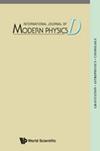有效暗能量无振荡的可行f(R)引力模型
IF 2.1
4区 物理与天体物理
Q3 ASTRONOMY & ASTROPHYSICS
引用次数: 0
摘要
在这项研究中,我们提出了一个特定可行的[公式:见文本]重力模型的重新参数化,将其表示为[公式:见文本]CDM模型的扰动。考虑中的[公式:见文本]重力模型包括两个参数,[公式:见文本]和[公式:见文本],它们控制所提议的模型与[公式:见文本]清洁发展机制的接近程度,允许任意接近。进一步证明了Hu-Sawicki (HS)模型是这种重参数化模型的极限情况。在现有文献的基础上,我们还推导了膨胀率的解析近似[公式:见文],结果表明,对于偏差参数的实际值[公式:见文],该解析近似与数值解在大范围红移范围内非常吻合。通过适当选择模型参数的值,我们绘制了宇宙学参数[公式:见文]、[公式:见文]、[公式:见文]、[公式:见文]和[公式:见文],以及寻态器量[公式:见文]、[公式:见文]、[公式:见文]和[公式:见文]。我们发现它们的现值(见[公式:见文本])与普朗克2018的观测结果和[公式:见文本]CDM模型预测的值一致。值得注意的是,所检查的宇宙学和状态探测器参数并没有显示出有效暗能量的显著振荡,这可能导致高红移的奇异和非物理解。通过使用[公式:见文本]的近似解析解,可以避免这种异常行为。此外,我们在引入的[公式:见文本]重力模型中对物质密度扰动的演化进行了详细的分析。结果表明,这种可行的[公式:见文本]引力模型在背景水平上与[公式:见文本]CDM模型几乎没有区别。本文章由计算机程序翻译,如有差异,请以英文原文为准。
A viable f(R) gravity model without oscillations in the effective dark energy
In this study, we propose a reparametrization of a specific viable [Formula: see text] gravity model to represent it as a perturbation of the [Formula: see text]CDM model. The [Formula: see text] gravity model under consideration includes two parameters, [Formula: see text] and [Formula: see text], which control how close the proposed model can be to [Formula: see text]CDM, allowing for arbitrary proximity. Furthermore, it is shown that the Hu–Sawicki (HS) model is a limiting case of this reparametrized model. Following the existing literature, we also derive an analytical approximation for the expansion rate [Formula: see text], which shows an excellent agreement between this analytical approximation and the numerical solution over a wide range of redshifts for realistic values of the deviation parameter [Formula: see text]. By appropriately selecting values for the model parameters, we plot the cosmological parameters [Formula: see text], [Formula: see text], [Formula: see text] and [Formula: see text], as well as the statefinder quantities [Formula: see text], [Formula: see text], [Formula: see text] and [Formula: see text]. We find that their present values (at [Formula: see text]) are consistent with the observations from Planck 2018 and the values predicted by the [Formula: see text]CDM model. It is important to note that the examined cosmological and statefinder parameters do not exhibit significant oscillations of effective dark energy, which could lead to singular and unphysical solutions at high redshifts. This anomalous behavior has been avoided here by utilizing the approximate analytical solution for [Formula: see text]. Additionally, we conduct a detailed analysis of the evolution of matter density perturbations within the introduced [Formula: see text] gravity model. The results demonstrate that this viable [Formula: see text] gravity model is practically indistinguishable from the [Formula: see text]CDM model at the background level.
求助全文
通过发布文献求助,成功后即可免费获取论文全文。
去求助
来源期刊

International Journal of Modern Physics D
地学天文-天文与天体物理
CiteScore
3.80
自引率
9.10%
发文量
181
审稿时长
4-8 weeks
期刊介绍:
Gravitation, astrophysics and cosmology are exciting and rapidly advancing fields of research. This journal aims to accommodate and promote this expansion of information and ideas and it features research papers and reviews on theoretical, observational and experimental findings in these fields. Among the topics covered are general relativity, quantum gravity, gravitational experiments, quantum cosmology, observational cosmology, particle cosmology, large scale structure, high energy astrophysics, compact objects, cosmic particles and radiation.
 求助内容:
求助内容: 应助结果提醒方式:
应助结果提醒方式:


